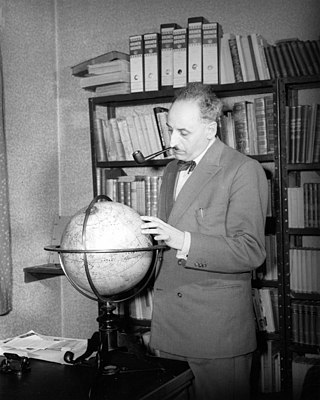Lincos is a constructed language first described in 1960 by Dr. Hans Freudenthal in his book Lincos: Design of a Language for Cosmic Intercourse, Part 1. It is a language designed to be understandable by any possible intelligent extraterrestrial life form, for use in interstellar radio transmissions. Freudenthal considered that such a language should be easily understood by beings not acquainted with any Earthling syntax or language. Lincos was designed to be capable of encapsulating "the whole bulk of our knowledge".

Hans Freudenthal was a Jewish German-born Dutch mathematician. He made substantial contributions to algebraic topology and also took an interest in literature, philosophy, history and mathematics education.

In geometry, a honeycomb is a space filling or close packing of polyhedral or higher-dimensional cells, so that there are no gaps. It is an example of the more general mathematical tiling or tessellation in any number of dimensions. Its dimension can be clarified as n-honeycomb for a honeycomb of n-dimensional space.
Astrolinguistics is a field of linguistics connected with the search for extraterrestrial intelligence (SETI).
In mathematics, the Freudenthal magic square is a construction relating several Lie algebras. It is named after Hans Freudenthal and Jacques Tits, who developed the idea independently. It associates a Lie algebra to a pair of division algebras A, B. The resulting Lie algebras have Dynkin diagrams according to the table at right. The "magic" of the Freudenthal magic square is that the constructed Lie algebra is symmetric in A and B, despite the original construction not being symmetric, though Vinberg's symmetric method gives a symmetric construction.
Rostislav Ivanovich Grigorchuk is a mathematician working in different areas of mathematics including group theory, dynamical systems, geometry and computer science. He holds the rank of Distinguished Professor in the Mathematics Department of Texas A&M University. Grigorchuk is particularly well known for having constructed, in a 1984 paper, the first example of a finitely generated group of intermediate growth, thus answering an important problem posed by John Milnor in 1968. This group is now known as the Grigorchuk group and it is one of the important objects studied in geometric group theory, particularly in the study of branch groups, automaton groups and iterated monodromy groups. Grigorchuk is one of the pioneers of asymptotic group theory as well as of the theory of dynamically defined groups. He introduced the notion of branch groups and developed the foundations of the related theory. Grigorchuk, together with his collaborators and students, initiated the theory of groups generated by finite Mealy type automata, interpreted them as groups of fractal type, developed the theory of groups acting on rooted trees, and found numerous applications of these groups in various fields of mathematics including functional analysis, topology, spectral graph theory, dynamical systems and ergodic theory.
James W. Cannon is an American mathematician working in the areas of low-dimensional topology and geometric group theory. He was an Orson Pratt Professor of Mathematics at Brigham Young University.
Educational Studies in Mathematics is a peer-reviewed academic journal covering mathematics education. It was established by Hans Freudenthal in 1968. The journal is published by Springer Science+Business Media and the editors-in-chief are Susanne Prediger and David Wagner. According to the Journal Citation Reports, the journal has a 2020 impact factor of 2.402.
Imre Z. Ruzsa is a Hungarian mathematician specializing in number theory.

In mathematics, a weighted Voronoi diagram in n dimensions is a generalization of a Voronoi diagram. The Voronoi cells in a weighted Voronoi diagram are defined in terms of a distance function. The distance function may specify the usual Euclidean distance, or may be some other, special distance function. In weighted Voronoi diagrams, each site has a weight that influences the distance computation. The idea is that larger weights indicate more important sites, and such sites will get bigger Voronoi cells.
Thomas Zaslavsky is an American mathematician specializing in combinatorics.
Luis Radford is professor at the School of Education Sciences at Laurentian University in Sudbury, Ontario, Canada. His research interests cover both theoretical and practical aspects of mathematics thinking, teaching, and learning. His current research draws on Lev Vygotsky's historical-cultural school of thought, as well as Evald Ilyenkov's epistemology, in a conceptual framework influenced by Emmanuel Levinas and Mikhail Bakhtin, leading to a non-utilitarian and a non-instrumentalist conception of the classroom and education.
In mathematical group theory, the automorphism group of a free group is a discrete group of automorphisms of a free group. The quotient by the inner automorphisms is the outer automorphism group of a free group, which is similar in some ways to the mapping class group of a surface.
In mathematics, the Freudenthal spectral theorem is a result in Riesz space theory proved by Hans Freudenthal in 1936. It roughly states that any element dominated by a positive element in a Riesz space with the principal projection property can in a sense be approximated uniformly by simple functions.
Dănuţ Marcu is a Romanian mathematician and computer scientist, who received his Ph.D. from the University of Bucharest in 1981. He claimed to have authored more than 400 scientific papers.

In mathematics, a near polygon is an incidence geometry introduced by Ernest E. Shult and Arthur Yanushka in 1980. Shult and Yanushka showed the connection between the so-called tetrahedrally closed line-systems in Euclidean spaces and a class of point-line geometries which they called near polygons. These structures generalise the notion of generalized polygon as every generalized 2n-gon is a near 2n-gon of a particular kind. Near polygons were extensively studied and connection between them and dual polar spaces was shown in 1980s and early 1990s. Some sporadic simple groups, for example the Hall-Janko group and the Mathieu groups, act as automorphism groups of near polygons.
In algebra, Freudenthal algebras are certain Jordan algebras constructed from composition algebras.
In geometry and crystallography, a stereohedron is a convex polyhedron that fills space isohedrally, meaning that the symmetries of the tiling take any copy of the stereohedron to any other copy.
Ascher Otto Wagner was an Austrian and British mathematician, specializing in the theory of finite groups and finite projective planes. He is known for the Dembowski–Wagner theorem.



